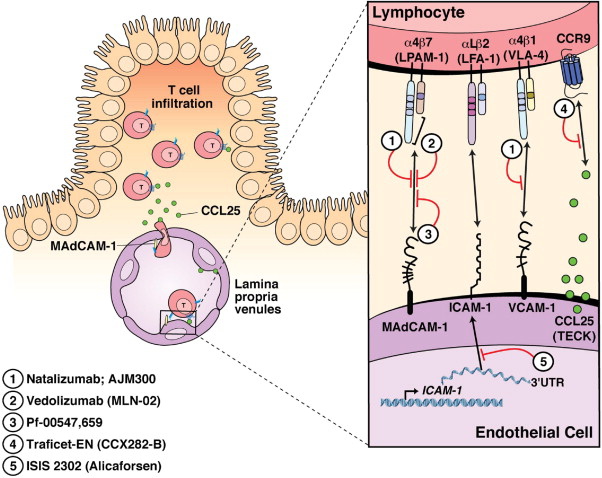
Ulcerative colitis is a chronic inflammatory bowel disease characterized by symptoms of bloody diarrhea, abdominal cramps, and fatigue.1 Current medical therapy has important limitations. Aminosalicylates2-4 are only modestly effective; glucocorticoids can cause unacceptable adverse events and do not provide a benefit as maintenance therapy. Tumor necrosis factor (TNF) antagonists, although efficacious,5,6 predispose patients to serious infection.7 Thus, new treatment strategies are needed.
The migration of leukocytes into inflamed intestinal tissue is highly regulated by specific molecular mechanisms. The α4β7 integrin,8 a cell-surface glycoprotein variably expressed on circulating B and T lymphocytes, interacts with mucosal addressin-cell adhesion molecule 19 (MAdCAM-1) on intestinal vasculature.10,11 Vedolizumab (Millennium Pharmaceuticals), a humanized monoclonal antibody that specifically recognizes the α4β7 heterodimer, selectively blocks gut lymphocyte trafficking without interfering with trafficking to the central nervous system.12-15 A predecessor molecule (MLN02) showed proof of concept in a phase 2 trial.16 Natalizumab, a monoclonal antibody with efficacy in multiple sclerosis and in Crohn's disease, inhibits both α4β1 and α4β7integrins and has been associated with progressive multifocal leukoencephalopathy (PML), a serious brain infection. Natalizumab and vedolizumab differ in that natalizumab blocks lymphocyte trafficking to multiple organs, including the brain and gut. 17,18 We evaluated the efficacy and safety of vedolizumab in patients with ulcerative colitis.
METHODS
Study Design
This phase 3, randomized, double-blind, placebo-controlled study consisted of separate induction and maintenance trials and was conducted at 211 medical centers (including 15 at which enrollment was discontinued) (see the Supplementary Appendix, available with the full text of this article at NEJM.org) in 34 countries from 2008 to 2012. The protocol was approved by an investigational review board at each center. All patients gave written informed consent. The study was conducted and reported in accordance with the protocol, available at NEJM.org.
Patients
Eligible patients were 18 to 80 years of age and had active ulcerative colitis, defined as a Mayo Clinic score19,20 (range, 0 to 12, with higher scores indicating more active disease) of 6 to 12, with a sigmoidoscopy subscore of at least 2, and disease that extended 15 cm or more from the anal verge. An additional eligibility criterion was documentation of unsuccessful previous treatment (i.e., lack of response or unacceptable adverse events) with one or more glucocorticoids, immunosuppressive medications (i.e., azathioprine and 6-mercaptopurine), or TNF antagonists (Table S1 in the Supplementary Appendix). Participants could continue to take mesalamine, up to 30 mg of prednisone (or the equivalent) per day, or immunosuppressive agents at stable doses. Rectal therapy with mesalamine or glucocorticoids was discontinued 2 weeks before screening. Patients were ineligible if they had received TNF antagonists within 60 days before enrollment or cyclosporine, thalidomide, or investigational drugs within 30 days before enrollment, or if they had been treated previously with vedolizumab, natalizumab, efalizumab, or rituximab. Other exclusion criteria were toxic megacolon, abdominal abscess, symptomatic colonic stricture, stoma, a history of colectomy, an increased risk of infectious complications (e.g. as a result of recent pyogenic infection, enteric pathogens detected on stool analysis, active or latent tuberculosis, immunodeficiency, hepatitis B or C, or recent live vaccination), clinically meaningful laboratory abnormalities, pregnancy or lactation, an unstable or uncontrolled medical disorder, an anticipated requirement for major surgery, colonic dysplasia or adenomas, and malignant neoplasms.
Screening and Baseline Studies
Assessments that were performed before randomization were physical and neurologic examinations, blood tests, stool analysis for enteric pathogens and fecal calprotectin,21 chest radiography, a tuberculin test (or QuantiFERON–TB Gold assay [Cellestis]),22 and symptom questionnaires for PML (see the Supplementary Appendix); in addition, demographic information was obtained. Eligible patients were scheduled for a visit immediately before randomization, when sigmoidoscopy was performed and baseline Mayo Clinic scores and scores on the Inflammatory Bowel Disease Questionnaire (IBDQ; range, 0 to 224, with higher scores indicating a better quality of life)23 were determined.
Randomization Procedures
For induction therapy, patients were randomly assigned, in a 3:2 ratio, to receive intravenous vedolizumab (300 mg) or placebo at days 1 and 15 (cohort 1), with two stratification factors: concomitant use or nonuse of glucocorticoids, and concomitant use or nonuse of immunosuppressive agents or prior use or nonuse of TNF antagonists. The proportion of patients with previous exposure to TNF antagonists was limited to 50%.
To fulfill sample-size requirements for the maintenance trial, additional patients were enrolled in an open-label group (cohort 2), which received the same active induction regimen given in the blinded study. Patients from both cohorts who had a clinical response to vedolizumab at week 6 (defined below) were randomly assigned, in a 1:1:1 ratio, to receive vedolizumab every 8 weeks (with placebo administered every other visit to preserve blinding), vedolizumab every 4 weeks, or placebo for up to 52 weeks. Randomization was stratified according to three factors: cohort, concomitant use or nonuse of glucocorticoids, and concomitant use or nonuse of immunosuppressive agents or prior use or nonuse of TNF antagonists. Patients who did not have a response to vedolizumab induction therapy at week 6 received vedolizumab (300 mg) every 4 weeks and were followed through week 52. Patients in cohort 1 who received placebo continued to receive placebo and were followed in a similar fashion.
Randomization was performed centrally with the use of computer-generated randomization schedules. Permitted concomitant medications for ulcerative colitis included aminosalicylates, glucocorticoids, and immunosuppressive agents. Aminosalicylates were continued at stable doses throughout the induction and maintenance periods. Glucocorticoid doses remained unaltered until week 6, then were tapered according to a defined regimen for patients with a clinical response to vedolizumab; immunosuppressants were maintained at stable doses throughout the induction and maintenance periods, except at U.S. sites, where they were discontinued after induction (see theSupplementary Appendix).
Follow-up
Patients were seen at weeks 2, 4, and 6 during induction therapy and every 4 weeks thereafter until week 52. At each visit, a partial Mayo Clinic score24 (consisting of the Mayo Clinic score minus the sigmoidoscopy subscore; range, 0 to 9, with higher scores indicating more active disease) was calculated, adverse events were noted, and neurologic-symptom questionnaires were administered, with positive responses to objective testing prompting further evaluation (see the Supplementary Appendix). Blood samples for serum chemical and hematologic testing were obtained every 8 weeks, and blood samples for assessment of anti-vedolizumab antibodies were obtained every 12 weeks. Assessments of fecal calprotectin concentrations and IBDQ scores were repeated at weeks 6, 30, and 52. Sigmoidoscopy was performed at baseline and weeks 6 and 52. Serum vedolizumab concentrations were measured at weeks 0, 2, 4, and 6 and approximately every 8 weeks thereafter. Testing for JC virus antibodies was not performed because a validated assay was not commercially available.
Outcomes
The primary outcome for induction therapy was a clinical response at week 6, defined as a reduction in the Mayo Clinic score of at least 3 points and a decrease of at least 30% from the baseline score, with a decrease of at least 1 point on the rectal bleeding subscale or an absolute rectal bleeding score of 0 or 1. Secondary outcomes at week 6 were clinical remission, defined as a Mayo Clinic score of 2 or lower and no subscore higher than 1, and mucosal healing, defined as an endoscopic subscore of 0 or 1. The primary outcome for maintenance therapy was clinical remission at week 52. Secondary measures, in ranked order, were durable clinical response (response at both weeks 6 and 52), durable clinical remission (remission at both weeks 6 and 52), mucosal healing at week 52, and glucocorticoid-free remission at week 52 in patients receiving glucocorticoids at baseline. Health-related quality of life was evaluated with the use of the IBDQ. Adverse events were classified with the use of the Medical Dictionary for Regulatory Activities, 25version 15.
Study Oversight
The study was designed and implemented by the GEMINI 1 Steering Committee (see theSupplementary Appendix) in collaboration with Millennium Pharmaceuticals, which held and analyzed the data. The study was monitored by means of on-site visits, with audits conducted at high-enrolling centers (see the Supplementary Appendix). Investigators, participating institutions, and the sponsor agreed to maintain confidentiality of the data. The first draft of the manuscript was written by the first author; the academic authors had access to the data and vouch for the validity of the data and analyses and the fidelity of the study to the protocol. All the authors made the decision to submit the manuscript for publication. Editorial support was funded by Takeda Pharmaceuticals International.
Statistical Analysis
Descriptive statistics were used to summarize differences in demographic and baseline characteristics among study groups. For the primary analysis of induction therapy, proportions of patients with a clinical response were compared with the use of the Cochran–Mantel–Haenszel chi-square test, with adjustment for stratification factors. Treatment was considered to have failed in patients who withdrew prematurely (Table S2 in the Supplementary Appendix). Rates of clinical remission and endoscopic healing were compared in a similar fashion. To control for multiple comparisons, a closed sequential procedure was used for primary and secondary outcomes, and a P value of 0.05 or lower was required to proceed to the analysis of each subsequent outcome. A similar procedure was used to analyze data from the trial of maintenance therapy. Given the comparisons of two vedolizumab doses with placebo, a Hochberg procedure26 was used to control the overall alpha error at 5% for testing of both dose regimens for each outcome. Nine subgroup analyses were prespecified to assess differences in remission rates at weeks 6 and 52 between patients receiving vedolizumab and those assigned to placebo.
We analyzed changes from baseline in the partial Mayo Clinic score, IBDQ score, and fecal calprotectin concentration separately for induction therapy and maintenance therapy, using analysis of covariance with adjustment for stratification variables. Between-group differences in glucocorticoid use were assessed by calculating median percentage changes from baseline. For patients who withdrew prematurely, the last observation was carried forward. Statistical tests were two-sided, with a P value of 0.05 or lower considered to indicate statistical significance. Analyses were performed according to the intention-to-treat principle. Descriptive statistics were used to compare incidences of adverse events between patients who received vedolizumab and those who received placebo.
It was anticipated that 35% of patients who received placebo and 53% of those who received vedolizumab would have a response during induction therapy. Corresponding estimates of remission rates at week 52 for the most effective vedolizumab regimen in the trial of maintenance therapy were 30% and 50%. The planned enrollment of 375 patients in the trial of induction therapy and 372 patients in the trial of maintenance therapy provided at least 90% power to detect differences with an alpha error of 5%.5,16
RESULTS
Randomization and Baseline Characteristics
In total, 1406 patients were evaluated for eligibility (Figure S1 in the Supplementary Appendix); 895 were enrolled and included in the analysis, of whom 58 (6.5%) did not meet one or more inclusion criteria or met one or more exclusion criteria (Table S3 in the Supplementary Appendix). In the trial of induction therapy, 225 patients were randomly assigned to receive vedolizumab and 149 to receive placebo (cohort 1). An additional 521 patients (cohort 2) received open-label vedolizumab. Baseline characteristics were similar in the placebo group and the vedolizumab group in cohort 1 (Table 1
).
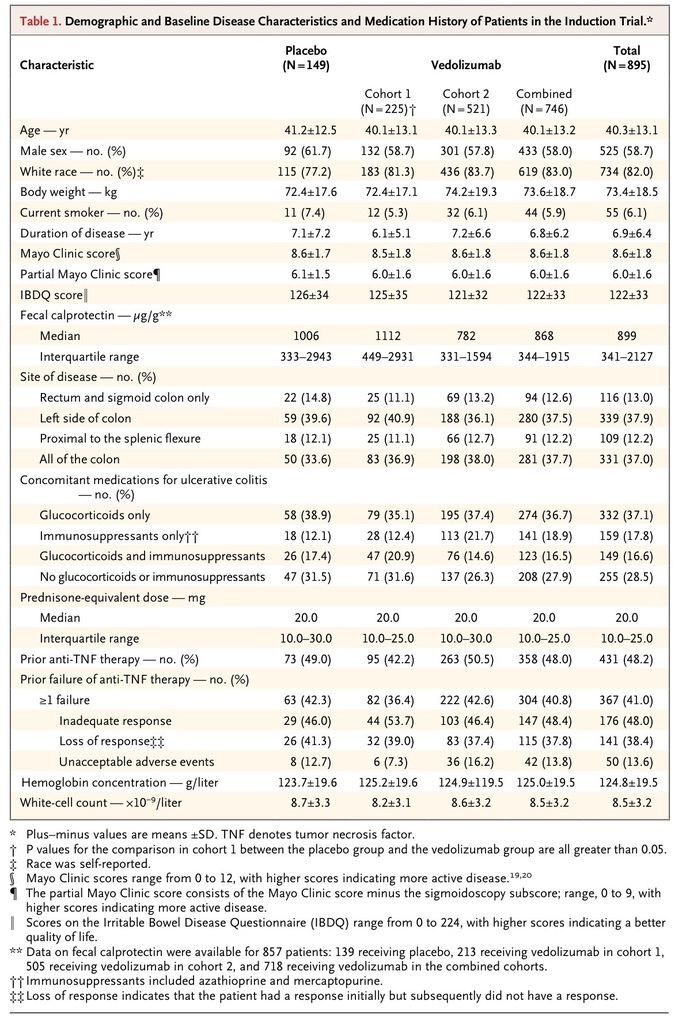
Previous treatment with TNF antagonists had failed in approximately 40% of patients.
Patients in either cohort who had a response to vedolizumab at week 6 were enrolled in the trial of maintenance therapy, with 122, 125, and 126 patients randomly assigned to receive vedolizumab every 8 weeks, vedolizumab every 4 weeks, and placebo, respectively. There were no clinically important differences in demographic or baseline characteristics or in medication history among the three groups (Table S4 in the Supplementary Appendix) or between patients who entered from cohort 1 (121 patients) and those who entered from cohort 2 (252 patients) (data not shown).
Outcomes in the Trial of Induction Therapy
At week 6, a total of 106 of the 225 patients receiving vedolizumab (47.1%) and 38 of the 149 patients receiving placebo (25.5%) had a clinical response (difference with adjustment for stratification factors, 21.7 percentage points; 95% confidence interval [CI], 11.6 to 31.7; P<0.001) (Table 2
). Efficacy was generally consistent among demographic subgroups and subgroups defined by baseline disease characteristics (Figure S2 in the Supplementary Appendix). A total of 38 patients receiving vedolizumab (16.9%) and 8 receiving placebo (5.4%) had clinical remission (P=0.001). Rates of mucosal healing were 40.9% (92 of 225 patients) with vedolizumab and 24.8% (37 of 149) with placebo (P=0.001) (Table S5 in the Supplementary Appendix). Of the 521 patients in cohort 2 who received open-label vedolizumab, 231 had a clinical response (44.3%), 100 had clinical remission (19.2%), and 191 had mucosal healing (36.7%).

Outcomes in the Trial of Maintenance Therapy
At week 52, patients who were randomly assigned to continue receiving vedolizumab were more likely to have clinical remission than were those randomly assigned to switch to placebo (51 of 122 patients receiving vedolizumab every 8 weeks [41.8%] and 56 of 125 receiving vedolizumab every 4 weeks [44.8%] vs. 20 of 126 receiving placebo [15.9%]; adjusted difference for vedolizumab every 8 weeks vs. placebo, 26.1 percentage points [95% CI, 14.9 to 37.2; P<0.001]; adjusted difference for vedolizumab every 4 weeks vs. placebo, 29.1 percentage points [95% CI, 17.9 to 40.4; P<0.001]) (Table 3
). Efficacy was generally consistent among demographic subgroups and subgroups defined by baseline disease characteristics (Figure S3 in the Supplementary Appendix).
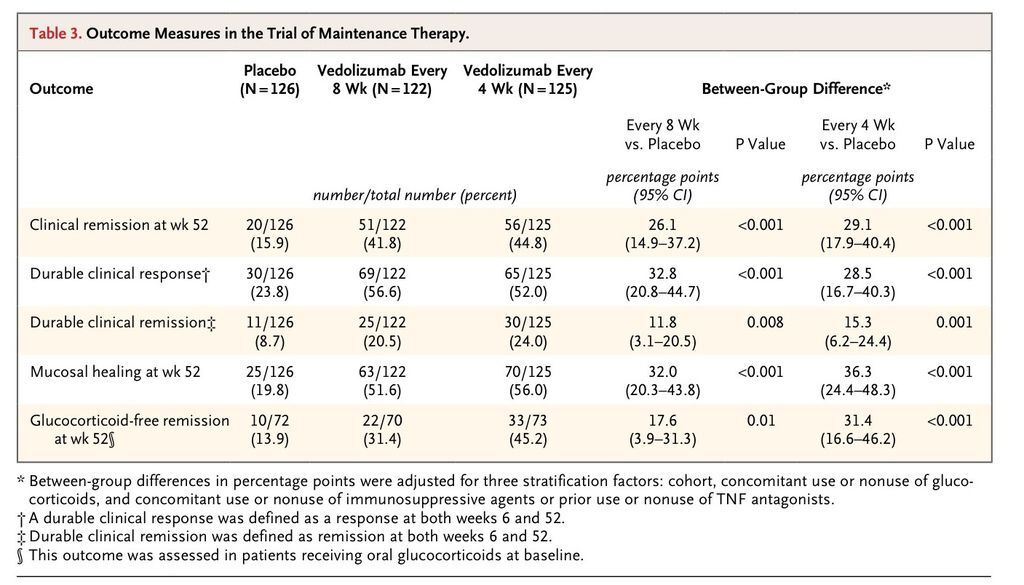
Rates of durable clinical response, durable clinical remission, mucosal healing, and glucocorticoid-free remission were higher among patients assigned to the vedolizumab regimens than among those assigned to placebo. No clear differences in efficacy were observed between the two vedolizumab regimens (Table 3, and Table S6 in the Supplementary Appendix). Concurrent treatment with glucocorticoids or immunosuppressants or previous treatment with TNF antagonists did not substantively affect the efficacy of vedolizumab (Figure S3 in the Supplementary Appendix).
Patients who received vedolizumab had greater improvements in the partial Mayo Clinic score, IBDQ score, fecal calprotectin concentration, and glucocorticoid use than patients assigned to placebo (Figure 1
). In a post hoc analysis, no clear differences in efficacy between the two vedolizumab regimens were apparent (Figure S3C in theSupplementary Appendix).
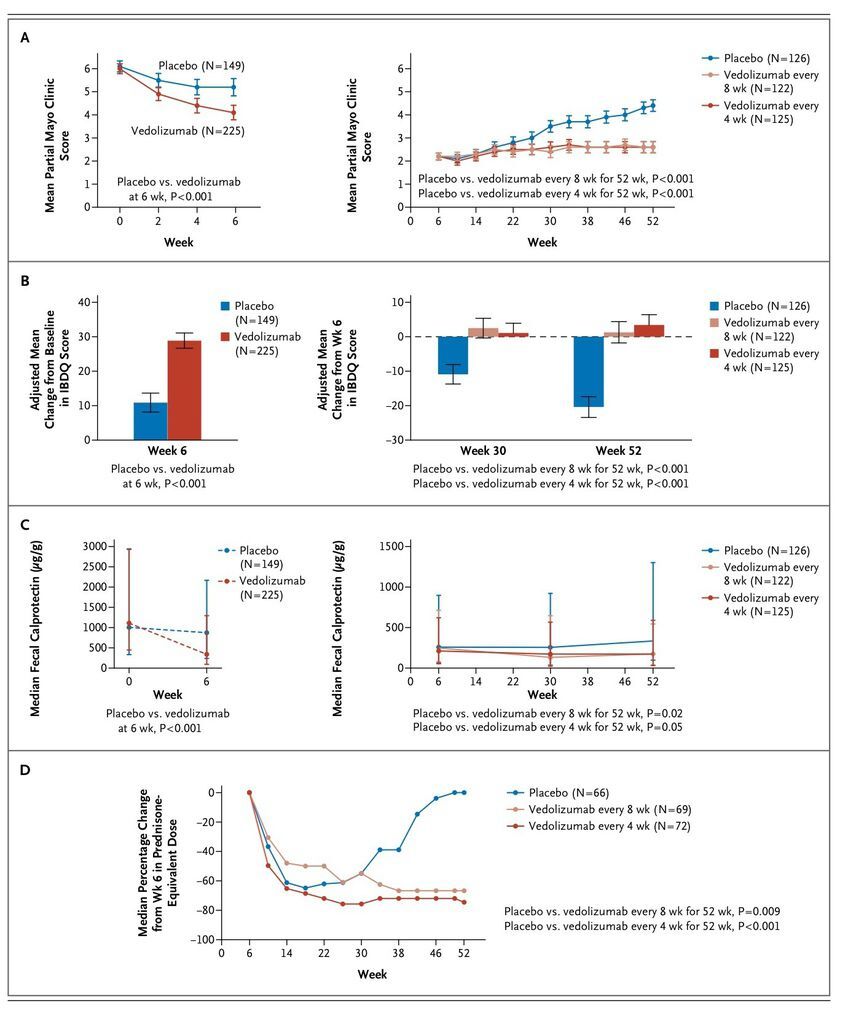
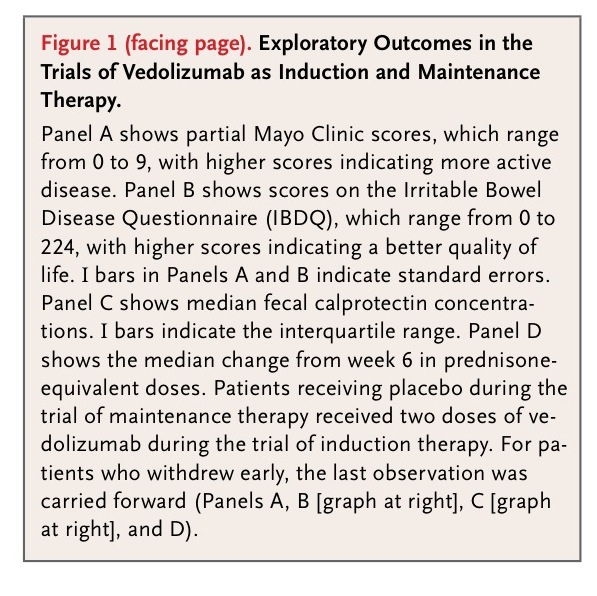
Safety
No important differences were observed among the study groups in the most commonly reported adverse events (Table 4
, and Tables S7 and S8 in the Supplementary Appendix). Serious infections were not more common with vedolizumab than with placebo. No cases of PML occurred. A 66-year-old man who received one dose of vedolizumab died 14 days later of an acute coronary syndrome (see the Supplementary Appendix). No significant differences in hematologic or serum chemical profiles or liver-function test results were identified among the study groups. Unlike other anti-integrin therapeutic regimens,27,28 vedolizumab treatment did not increase peripheral-blood total lymphocyte counts. Clinically important infusion reactions were few; three cases (two with detectable antivedolizumab antibodies) resulted in drug discontinuation. No cases of anaphylaxis or serum sickness were observed.
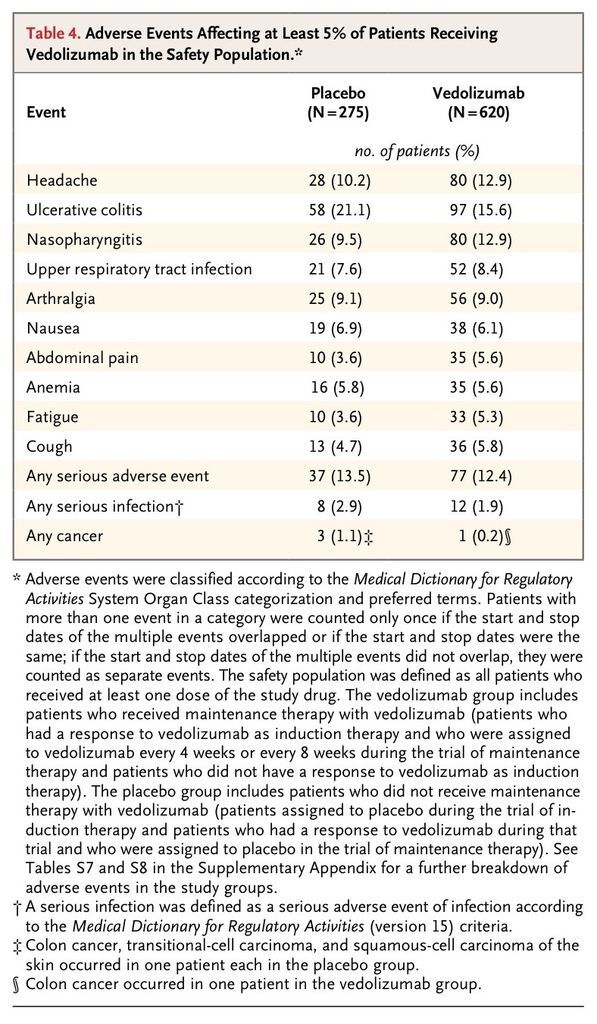
Pharmacokinetics and Immunogenicity
The mean (±SD) trough vedolizumab concentration was 27.9±15.5 μg per milliliter (in 654 patients) at week 6. At steady state, mean vedolizumab concentrations were 11.2±7.2 μg per milliliter with vedolizumab every 8 weeks (in 77 patients) and 38.3±24.4 μg per milliliter with vedolizumab every 4 weeks (in 220 patients); both dosing schedules resulted in more than 95% saturation of α4β7 of CD4+CD45RO+ T cells in the peripheral circulation (data not shown). Correlations between drug level and response during induction therapy and maintenance therapy are shown in Figure S4 and S5, respectively, in theSupplementary Appendix. Of 620 vedolizumab-treated patients with available blood samples, 23 (3.7%) had samples that were positive for anti-vedolizumab antibodies at any time, and 6 (1.0%) had samples that were persistently positive (i.e., ≥2 consecutive positive samples) through week 52. Concomitant immunosuppressive therapy was associated with decreased immunogenicity (data not shown).
DISCUSSION
In these trials, vedolizumab was effective for inducing and maintaining a response and remission in patients with ulcerative colitis. All prespecified primary and secondary outcomes in the trials of induction and maintenance therapy were superior in vedolizumab-treated patients versus those who received placebo. Longitudinal assessments of partial Mayo Clinic scores, IBDQ scores, fecal calprotectin concentrations, and use or dose of glucocorticoids provided further evidence of a treatment benefit. Disease had been refractory to other treatments in many patients; treatment with TNF antagonists, agents usually reserved for more severe disease,29 had previously failed in approximately 40% of patients, many of whom had not had a response (Table 1). Of particular relevance was the benefit of vedolizumab therapy with respect to glucocorticoid-free remission. At week 52, this outcome was observed in 31.4% of the patients who received vedolizumab every 8 weeks and in 45.2% of those who received vedolizumab every 4 weeks, as compared with 13.9% of patients who received placebo. This benefit was not appreciably affected by status with respect to concurrent or prior treatments for ulcerative colitis.
Although the trial of maintenance therapy was not large enough or of sufficient duration to estimate the risk of uncommon adverse events, rates of serious, opportunistic, or enteric infections with vedolizumab did not differ significantly from the rates with placebo, and no dose–response relationship was observed. Infections were more common in a companion trial, also reported in this issue of the Journal, of vedolizumab in patients with Crohn's disease.30 Longer-term epidemiologic studies and clinical experience are required to more fully assess the risk of adverse events associated with vedolizumab.
As of February 2013, no cases of PML had been reported in approximately 3000 patients exposed to vedolizumab for a median of 18.8 months (mean, 20.9 months; range, 4 to 67). Approximately 2400 of these patients (80%) had previously received immunosuppressive agents, and 900 were exposed to vedolizumab for more than 24 months. Testing for JC virus antibodies was not performed in this study, owing to the lack of a validated commercially available assay. The reported prevalence of detectable antibodies to JC virus, which are indicative of prior exposure, has ranged from 50 to 80% in diverse populations, including patients with Crohn's disease.31-38 In comparison, the incidence of PML among patients receiving natalizumab therapy for multiple sclerosis exceeds 1 case in 500 patients overall (range, approximately 1 in 3000 [0.3 in 1000] among patients with ≤24 months' exposure and no prior use of immunosuppressive agents to approximately 1 in 150 [6.7 in 1000] among those with >24 months' exposure and prior use of immunosuppressive agents).39
The development of neutralizing antibodies can increase drug clearance, reduce treatment efficacy, and affect safety. In contrast to our experience with MLN02, the precursor of vedolizumab, the rate of sensitization observed with vedolizumab was relatively low, despite substantially longer exposure. This finding may be attributable to an improved manufacturing process and the potentially tolerizing effect of the higher vedolizumab doses administered in this study.
Our study had important limitations. First, it was not designed to identify the time of the maximal effect of vedolizumab as induction therapy. Greater efficacy may be obtained by extending induction treatment beyond 6 weeks. Second, we did not identify a minimally effective dose regimen, because both treatment schedules fully saturated the α4β7 integrin on peripheral-blood lymphocytes and no substantial efficacy differences were noted between regimens. These observations suggest that vedolizumab given every 8 weeks may be an acceptable starting regimen, with the possibility of dose intensification if the response is inadequate.
In conclusion, vedolizumab is effective as both induction and maintenance therapies for patients with moderately to severely active ulcerative colitis.





 留言列表
留言列表
 線上藥物查詢
線上藥物查詢 